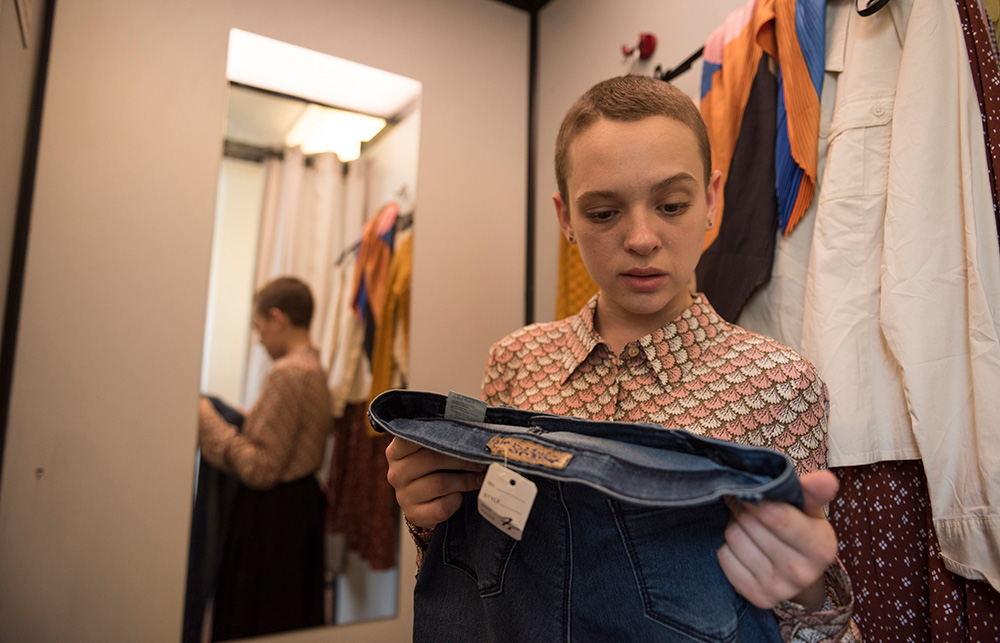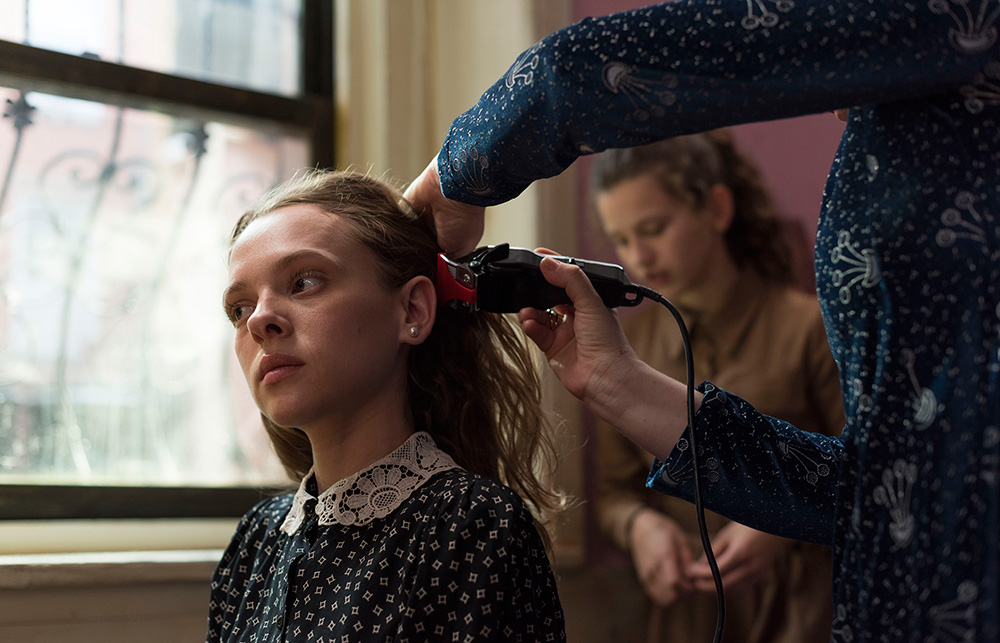获得8项艾美奖提名的《离经叛道》,是怎么选角和选服装的?
如何把黛博拉•费尔德曼的回忆录《离经叛道:逃离我的哈西德血统》改编成电视,而且即使最终呈现出的作品只有部分基于真实事件,还是要让它看起来尽可能真实?
《离经叛道》的选角导演埃斯特•克林和服装设计师贾斯汀•西摩在接受《财富》杂志采访时表示,很重要的一点是找到合适的演员,认真研究、精心做好剧组服装设计。克林和西摩都因为奈飞(Netflix)这部限定剧中获得了今年艾美奖的提名。
该剧讲了来自布鲁克林威廉斯堡的哈西德派犹太教女子埃斯蒂(希拉•哈斯饰)决定离开布鲁克林去柏林的故事,因此需要在多个国家寻找合适的演员。除了要找会说意第绪语的演员(意第绪语在影片中非常重要,但如今会说的人已经不多了),选角团队还需要找到能体现某些特点的演员。
主角哈斯和阿米特•拉哈夫(后者饰演埃斯蒂的丈夫扬基)是以色列人,他们必须得现学意第绪语。但是,尽管存在语言障碍,仍然有多方面因素让人觉得他们就是最佳人选。
“她很好地刻画了孩子气和女人味之间微妙的平衡感,这个角色既坚强又脆弱,既聪明又天真,”克林这样评价哈斯。克林还说,拉哈夫的表演很“成熟”,也表现出了一种和他的角色相称的天真。

选角导演还在伦敦、德国、纽约的一家剧院和其他地方寻找演员。克林说,聚集的制片人也参与了进来,正是他们请来了耶夫•威尔布什饰演莫伊什。
“他们希望他能在戏里演点什么角色……但他们不确定具体演谁。”克林说,“我感觉莫伊什这个角色一开始适合年纪更大的演员,但他们为他做了调整。”
西摩说,虽然费尔德曼的回忆录也讲述了一些周遭环境,但剧组还是在威廉斯堡做了很多实地调研。她对萨特玛(Satmar)社区给予了特别关注,因为费尔德曼曾经是这个教派的一员。
“我们花了一周时间进行社区实地调研,逛当地商店,我们进行了一次踩点之旅,四处拍照。”西摩告诉《财富》杂志。我们采访了街上一些愿意接受采访的人——有很多人不愿意,但也有一些人对我们所做的事情非常感兴趣。商店里的工作人员都很愿意敞开心扉,给我们解释什么是什么。”
服装在展示埃斯蒂的旅程中发挥了很大的作用;西摩说,这个角色就像拼图的中心,围绕她构建了一个世界。年轻的埃斯蒂更多的是穿便装。后来,等她结婚了,她开始穿更有结构感的衣服——在她结婚的第一周,她的衣服色彩更鲜艳,场景里也经常出现一些亮点,目的是强调她的身份发生了变化。等埃斯蒂到了柏林,她的穿衣风格出现了变化——尽管一开始变得很慢——她开始从在这个陌生城市里遇到的其他女性那里一点一点学习积累自己的着装风格。
“我和黛博拉谈过她的变化,她说这是一个非常缓慢的过程。”西摩说,“不过她喜欢穿牛仔裤,这就是我为什么直接跳到了牛仔裤,因为她真的非常喜欢牛仔裤。”

“随着故事的发展,[埃斯蒂]的领口开低了点,衣服的面料更柔软、更性感,”她补充道。
在埃斯蒂住的地方,配角(尤其是女性)的穿着也可以彰显个性。各种颜色和设计的头巾起了很大作用。西摩很快了解到,大牌头巾非常受欢迎,比如菲拉格慕(Ferragamo)和爱马仕(Hermes)的头巾。但因为没有太多预算买不了那么多大牌,她给埃斯蒂的岳母米里亚姆买了几条真的牌子货,给其他角色准备了一些假的和二手头巾。
香奈儿风格的定制服装也是米里亚姆衣橱的一部分,既体现了她在家庭中的女家长角色,也显示出“她们家比埃斯蒂家稍微富裕一点。”
虽然很多衣服——尤其是男人的衣服——买的是成衣,但西摩确实花时间做了一些服饰,包括一些女性的便服和头巾。埃斯蒂的婚纱是在eBay上买的,但买回来后进行了修改加工。
“希拉•哈斯是一位身材非常娇小的年轻姑娘……我们买到的裙子正合我心意,但我们还是把整条裙子拆成了几片,把裙摆裁掉了大约18英寸。我把腰线抬高了。”西摩说,“这么改的原因是我想让它更有公主的感觉,也是想模仿黛博拉•费尔德曼的风格。”
西摩买的什特莱牟(shtreimel)——已婚的哈西德男性在安息日和节日时戴的圆形毛皮帽子——是汉堡的一家戏剧公司制作的,部分是出于预算原因,部分原因是为了避免购买新的毛皮。而且,纽约卖正宗shtreimel的商店也不会卖给她。
她笑着说:“(这些帽子)送到时,刚从盒子里拿出来的时候,非常非常蓬松。”她补充道,后来她在帽子上涂上了厚厚的发胶,然后一直梳,把它们梳得更像真正的shtreimel。
西摩教演员和服装助理们各种服装应该怎么穿,她还打印了便笺,任何人需要查阅的时候都可以用。她说:“我还会把试装的照片夹在衣服上,存在剧本里,这样,哪怕我不在场,他们也能清楚看到衣服应该怎么穿。”
这并不是演员们得到的唯一指导——在选角过程中,他们就提前得知了要扮演的角色在这部剧里的重要情节。哈斯在埃斯蒂婚后的一个场景中剃了光头,一些哈西德派的妇女会这么做。

“如果演员不愿意剃光头,就不用试镜了。我们不想浪费任何人的时间,”克林说。除了会告诉演员一些身体上的要求,比如剃光头,或者和其他演员演亲热戏,克林说,他们还会告诉演员故事的文化背景,会提前告诉演员是否需要用意第绪语试镜。
克林说这部剧有非常“特别”和“独特”的气质,他也十分享受制作这部剧的过程。
“这是一个由女性讲述的关于某一个特定女性的故事,是一个人的真实经历,但它变成了一个关于人追寻自己的声音、身份和自由的普世故事,”克林说。“让人感到新鲜又有趣。”(财富中文网)
《离经叛道》获得8项艾美奖提名。除了获得最佳选角和现代剧最佳服装设计提名外,该剧还获得了最佳导演、最佳配乐、最佳女主角、最佳原创主题曲、最佳编剧和最佳限定剧提名。
译者:Agatha
如何把黛博拉•费尔德曼的回忆录《离经叛道:逃离我的哈西德血统》改编成电视,而且即使最终呈现出的作品只有部分基于真实事件,还是要让它看起来尽可能真实?
《离经叛道》的选角导演埃斯特•克林和服装设计师贾斯汀•西摩在接受《财富》杂志采访时表示,很重要的一点是找到合适的演员,认真研究、精心做好剧组服装设计。克林和西摩都因为奈飞(Netflix)这部限定剧中获得了今年艾美奖的提名。
该剧讲了来自布鲁克林威廉斯堡的哈西德派犹太教女子埃斯蒂(希拉•哈斯饰)决定离开布鲁克林去柏林的故事,因此需要在多个国家寻找合适的演员。除了要找会说意第绪语的演员(意第绪语在影片中非常重要,但如今会说的人已经不多了),选角团队还需要找到能体现某些特点的演员。
主角哈斯和阿米特•拉哈夫(后者饰演埃斯蒂的丈夫扬基)是以色列人,他们必须得现学意第绪语。但是,尽管存在语言障碍,仍然有多方面因素让人觉得他们就是最佳人选。
“她很好地刻画了孩子气和女人味之间微妙的平衡感,这个角色既坚强又脆弱,既聪明又天真,”克林这样评价哈斯。克林还说,拉哈夫的表演很“成熟”,也表现出了一种和他的角色相称的天真。
选角导演还在伦敦、德国、纽约的一家剧院和其他地方寻找演员。克林说,聚集的制片人也参与了进来,正是他们请来了耶夫•威尔布什饰演莫伊什。
“他们希望他能在戏里演点什么角色……但他们不确定具体演谁。”克林说,“我感觉莫伊什这个角色一开始适合年纪更大的演员,但他们为他做了调整。”
西摩说,虽然费尔德曼的回忆录也讲述了一些周遭环境,但剧组还是在威廉斯堡做了很多实地调研。她对萨特玛(Satmar)社区给予了特别关注,因为费尔德曼曾经是这个教派的一员。
“我们花了一周时间进行社区实地调研,逛当地商店,我们进行了一次踩点之旅,四处拍照。”西摩告诉《财富》杂志。我们采访了街上一些愿意接受采访的人——有很多人不愿意,但也有一些人对我们所做的事情非常感兴趣。商店里的工作人员都很愿意敞开心扉,给我们解释什么是什么。”
服装在展示埃斯蒂的旅程中发挥了很大的作用;西摩说,这个角色就像拼图的中心,围绕她构建了一个世界。年轻的埃斯蒂更多的是穿便装。后来,等她结婚了,她开始穿更有结构感的衣服——在她结婚的第一周,她的衣服色彩更鲜艳,场景里也经常出现一些亮点,目的是强调她的身份发生了变化。等埃斯蒂到了柏林,她的穿衣风格出现了变化——尽管一开始变得很慢——她开始从在这个陌生城市里遇到的其他女性那里一点一点学习积累自己的着装风格。
“我和黛博拉谈过她的变化,她说这是一个非常缓慢的过程。”西摩说,“不过她喜欢穿牛仔裤,这就是我为什么直接跳到了牛仔裤,因为她真的非常喜欢牛仔裤。”
“随着故事的发展,[埃斯蒂]的领口开低了点,衣服的面料更柔软、更性感,”她补充道。
在埃斯蒂住的地方,配角(尤其是女性)的穿着也可以彰显个性。各种颜色和设计的头巾起了很大作用。西摩很快了解到,大牌头巾非常受欢迎,比如菲拉格慕(Ferragamo)和爱马仕(Hermes)的头巾。但因为没有太多预算买不了那么多大牌,她给埃斯蒂的岳母米里亚姆买了几条真的牌子货,给其他角色准备了一些假的和二手头巾。
香奈儿风格的定制服装也是米里亚姆衣橱的一部分,既体现了她在家庭中的女家长角色,也显示出“她们家比埃斯蒂家稍微富裕一点。”
虽然很多衣服——尤其是男人的衣服——买的是成衣,但西摩确实花时间做了一些服饰,包括一些女性的便服和头巾。埃斯蒂的婚纱是在eBay上买的,但买回来后进行了修改加工。
“希拉•哈斯是一位身材非常娇小的年轻姑娘……我们买到的裙子正合我心意,但我们还是把整条裙子拆成了几片,把裙摆裁掉了大约18英寸。我把腰线抬高了。”西摩说,“这么改的原因是我想让它更有公主的感觉,也是想模仿黛博拉•费尔德曼的风格。”
西摩买的什特莱牟(shtreimel)——已婚的哈西德男性在安息日和节日时戴的圆形毛皮帽子——是汉堡的一家戏剧公司制作的,部分是出于预算原因,部分原因是为了避免购买新的毛皮。而且,纽约卖正宗shtreimel的商店也不会卖给她。
她笑着说:“(这些帽子)送到时,刚从盒子里拿出来的时候,非常非常蓬松。”她补充道,后来她在帽子上涂上了厚厚的发胶,然后一直梳,把它们梳得更像真正的shtreimel。
西摩教演员和服装助理们各种服装应该怎么穿,她还打印了便笺,任何人需要查阅的时候都可以用。她说:“我还会把试装的照片夹在衣服上,存在剧本里,这样,哪怕我不在场,他们也能清楚看到衣服应该怎么穿。”
这并不是演员们得到的唯一指导——在选角过程中,他们就提前得知了要扮演的角色在这部剧里的重要情节。哈斯在埃斯蒂婚后的一个场景中剃了光头,一些哈西德派的妇女会这么做。
“如果演员不愿意剃光头,就不用试镜了。我们不想浪费任何人的时间,”克林说。除了会告诉演员一些身体上的要求,比如剃光头,或者和其他演员演亲热戏,克林说,他们还会告诉演员故事的文化背景,会提前告诉演员是否需要用意第绪语试镜。
克林说这部剧有非常“特别”和“独特”的气质,他也十分享受制作这部剧的过程。
“这是一个由女性讲述的关于某一个特定女性的故事,是一个人的真实经历,但它变成了一个关于人追寻自己的声音、身份和自由的普世故事,”克林说。“让人感到新鲜又有趣。”(财富中文网)
《离经叛道》获得8项艾美奖提名。除了获得最佳选角和现代剧最佳服装设计提名外,该剧还获得了最佳导演、最佳配乐、最佳女主角、最佳原创主题曲、最佳编剧和最佳限定剧提名。
译者:Agatha
How does one adapt a memoir like Deborah Feldman’s Unorthodox: The Scandalous Rejection of My Hasidic Roots for television and make it feel as real as possible, even if the end result is a story only partially based on true events?
Finding the right actors and putting together a carefully researched onscreen wardrobe play a role, as Unorthodox casting director Esther Kling and costume designer Justine Seymour explained in conversations with Fortune. Kling and Seymour are each Emmy nominees this year for their work on the Netflix limited series.
The series follows a Hasidic Jewish woman from Williamsburg, Brooklyn named Esty (Shira Haas), who decides to leave her community and go to Berlin—and finding the appropriate actors was an international effort. In addition to looking for actors who could speak Yiddish—a language that features heavily in the production but isn’t widely spoken today—the casting team also needed actors who could embody certain characteristics.
The leads, Haas and Amit Rahav (who plays Esty’s husband, Yanky)—both from Israel—had to learn Yiddish. But there were various other reasons why they felt right for their parts despite the language barrier.
“She portrayed that thin line of woman-child—of somebody being so strong while so fragile, being very smart and naïve at the same time,” says Kling of Haas. Kling adds that Rahav—whose acting was “mature”—also expressed a level of naiveté that suited his character.
Casting directors also looked for actors in London, Germany, a theater in New York, and other locales. The producers were also involved, Kling says, and were the ones who brought actor Jeff Wilbusch (Moishe) on for the project.
“They wanted him in the series… they weren’t sure for which part,” Kling says. “I believe the part of Moishe was written for an older actor, and they adapted it for him.”
While Feldman’s memoir informed some of what the crew did, there was also a lot of research on the ground in Williamsburg, says Seymour. She specifically focused on the Satmar community, the sect Feldman was once part of.
“We spent a week on the ground actually really doing research on the community, going into shops; we went on a walkthrough tour, we took photographs," Seymour tells Fortune. We spoke to some people on the streets that were willing to—a lot of them weren’t, but some were really fascinated about what we were doing. People working in the stores were quite willing to open up and explain what things were.”
Costuming played a large part in illustrating Esty’s journey; the character was like the center of a jigsaw puzzle, Seymour says, with a world built around her. Younger Esty is seen more often in housedresses. Later, when she gets married, she starts to wear more structured clothing—dressing with a little more color and sparkle in scenes taking place during her first week of marriage to emphasize her changed status. After Esty reaches Berlin, she starts to change the way she dresses—albeit very slowly at the start—picking up some of her style from other female characters she meets in this unfamiliar city.
“I had spoken to Deborah about her personal transformation and she said it was a really slow process,” Seymour says. “Although she loved wearing jeans, so that’s why I jumped straight in with jeans, because she really, really enjoyed jeans.”
“As the story progresses, [Esty’s] neckline becomes a little bit lower, her fabrics become a bit more softer and a bit more sensual,” she adds.
Personality traits are also reflected in the clothing worn by supporting characters—particularly the women—in Esty’s community. Headscarves, featuring various colors and designs, played a huge part. Seymour quickly learned that designer scarves in particular, such as those by Ferragamo and Hermes, are very popular. Since she didn’t have the budget to buy too many of those, she bought a handful of real ones for Esty’s mother-in-law Miriam and supplemented those with fakes and secondhand scarves for other characters.
Tailored, Chanel-esque outfits were also part of Miriam’s closet, reflecting her role as the matriarch in her family, while also showing that “she was slightly wealthier than the family that Esty was coming from.”
While many clothes—especially the men's—were purchased for the production, Seymour did take the time to construct some clothing, including some of the women’s housedresses and some turbans. Esty’s wedding dress was originally purchased on eBay, but then reworked.
“Shira Haas is an absolutely petite young lady… the dress that we bought was exactly what I wanted, but then we cut the whole thing to pieces, we took out probably about 18 inches from the hem. I lifted the waist,” Seymour says. “And I just changed it around because I wanted it to feel more princess-y, and I also wanted it to also emulate the one that Deborah Feldman had had herself.”
Seymour also opted to have the shtreimels, circular fur hats worn by married Hasidic men on Shabbat and festive occasions, built by a theater company in Hamburg—partly for budgetary reasons, and partly to avoid buying new fur. Besides, the stores in New York selling authentic shtreimels wouldn’t sell them to her.
“When [the hats] actually arrived and came out of the box, they were so floppy,” she says, laughing, adding that she lacquered them with heavy hairspray and combed them until they more closely resembled actual shtreimels.
Seymour taught the actors and her costumers how specific outfits should be worn, while printing out notes that were available for anyone who needed to look something up. “I’d also have the fitting photographs actually attached to the clothing and in the continuity book, so that if I wasn’t available, they could see exactly how it was supposed to be worn,” she says.
That wasn’t the only coaching the actors got—they also received advance notice about any major plot points concerning their characters during the casting process. In one scene after Esty is married, Haas has her head shaved, a practice observed by some Hasidic women.
“You don’t bring somebody in for an audition if she’s not willing to shave her head. We don’t want to waste anybody’s time,” Kling says. In addition to physical aspects of their roles like shaving one’s head or sharing intimate scenes with another actor, Kling says, the cast was informed of whether they needed to audition in Yiddish, in addition to being given some context about the cultural lens through which they were telling the story.
Kling, who describes the production as having “special” and “unique” qualities, ultimately enjoyed the process of working on the series.
“This is a story told by women about a very specific woman, somebody’s true story, but it became a universal story about a person looking for their voice and identity and freedom,” says Kling. “There was a fresh and fun feeling about that.”
Unorthodox is nominated for eight Emmy Awards. In addition to being nominated for outstanding casting and outstanding contemporary costumes, it is also nominated for directing, music composition, outstanding lead actress, original main title music, writing, and outstanding limited series.













